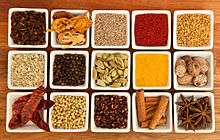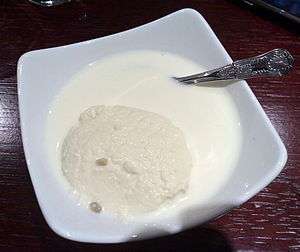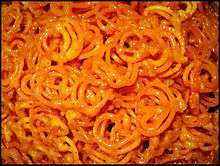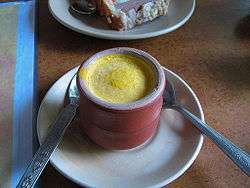Bhojpuri cuisine
 |
| This article is part of the series |
| Indian cuisine |
|---|
|
Regional cuisines
|
|
Ingredients, types of food |
|
See also
|
|
Bhojpuri cuisine (Nepali: भोजपुरी परिकार; Hindi: भोजपुरी खाना) is a part of North Indian and Nepalese cuisine cuisine and a style of food preparation common amongst the Bhojpuri people living in Bhojpuri region of Nepal, Bihar and Uttar Pradesh. Bhojpuri foods are mostly mild and are less hot in term of spices used, but could be hotter and spicier according to individual preference. The food is tailor-made for Bhojpuri lifestyle in which the rural folk burn up a lot of calories in the fields. Bhojpuri people take pride in celebrating various festivals and religious rites with food; as a result, their food resembles the delicacies offered to deities.
Bhojpuri peoples enjoy eating both vegetable and meat dishes. The cuisine is heavily influenced by Mughlai cuisine and its neighbouring Awadhi cuisine.
Unlike western perception, in which any Indian gravy dish is called curry, Bhojpuri cuisine traces no history with use of curry powder or curry leaves. The rich gravy dishes of this region, in fact all of North India where curry leaf is an alien spice, can be considered stews rather than curries.
Staple diet
Wheat and rice are the staple diet of majority of the peoples. Lentils (daal), beans (lobiya, rajma), meat (mutton, lamb and chicken; beef and pork are avoided), green vegetables (sabzi), leafy vegetables (saag), paneer, freshwater prawns (jhinga) and fish (machhari) are major constituent of the regular diet of the peoples.
Breakfast
Breakfast in the region is roti based and includes a variety of breads made up of whole wheat or refined wheat flour which includes roti, parautha, stuffed parauthas and is made with sabzi, dahi, or raita.
On special occasions Halwa-Puri, Kheer/sevai-Puri, Pua-Dahi, Chhola-Bhatura or Naan served with any meat dish are commonly served as breakfast. A more common breakfast served as street food includes Puri-Sabzi, Kachori and Jalebi.
Lunch
Lunch is rice based and includes Dal bat (split beans like chana dal, masoor dal, moong dal, urad dal, arhar/tur dal etc. are pressure cooked with water, turmeric powder and salt), sabzi-korma (vegetable or meat cooked in rich but mildly-spicy and balanced gravy), chokha (boiled, roasted and mashed potatoes, eggplants, tomatoes are mixed with several herbs and seasoning), chutney (dhaniya ka chutney or coriander chutney is the most traditional chutney of the region with rich flavour of coriander, green chilli, garlic, lemon and mustard oil), bhujia (pan fried potatoes cut in finger shapes), pickle and may also include rotis for those who prefer it over rice. On special occasions, there are several rice dishes like polao, biryani etc. are served and there several changes can be observed in the lunch, in fact can be completely changed and then it could have many delicious dishes, sweets and savouries.
Snacks
Generally served with tea, at evening time. It includes many kind of snacks mostly deep fried and salted. Most of the times, as a substitute for it, a handful and generous amount of dry fruits are eaten like kishmish (raisins), badam (almonds), khajur/chohara (dates), zameeni badam/chinia badam (peanuts), akharot (walnuts), chillgooza (pinenut), kaju (cashews), pista (pistachios) and anjeer (dried figs) soaked in milk.
Dinner
Dinner is also roti based and is eaten with sabzi-korma or roti is broken into a bowl of hot milk (can be sweetened), and then eaten, it is often called doodh-roti. Sometimes, litti is grilled over charcoal or is baked in cowdung cakes or charcoal in a clay oven and is eaten with chokha or murga (chicken korma). Dinner could change at special occasion and can be replaced by meat dishes like korma (meat with gravy), kebab and kofta (meat balls with spicy gravy) and served with tandoori roti (harder than the usual pan baked roti) or naan and Salaad (salad).
Satvik Khana
There is a tradition of eating Satvik Khana (Sentient food) in the holy city of Banaras.
It is a Lacto Vegetarian diet and excludes the uses of garlic and onion. It is mostly observed by the Brahmins and Pandits.
Non Vegetarianism
Since ancient times, peoples of this region have been practicing non vegetarian along with vegetarian diet to meet proper need of protein, vitamins and fat. Also non vegetarian dishes are seen as delicacies and is eaten with great relish. It has always been a custom to serve the guests, any non vegetarian dish at least once in their term of stay.
In Vedic times, meat of goats, sheep, oxen, bulls, swines and horses were popular. But after the decline of Vedic Hinduism and uprising of Modern Hinduism along with direct influences from newborn religions like Buddhism and Jainism resulted in decrease of heavy dependence upon meat and ended up with only few kinds of meat yielding animals being edible like goat, sheep and swine, and because Cows got an auspicious position in modern Hinduism, the meat of cows, oxen and bulls became taboo. Later on after the influence of Islam, swine also became a taboo. But still many Hindu families in remote areas of this region hunt for wild boars and Muslims can be still found enjoying beef and meat of Nilgai (Asian antelope). Nilgai is avoided among Hindus because they are mistaken to be cow like cattles and hence sacred.
After the arrival of British rulers, poultry became popular and now has become one of the largest contributor in meat yielding animals. But still mutton is regarded as the superior meat over poultry and fish.
Fishes have also been popular since ancient times due to a large number of big and small rivers flowing through the region. Freshwater fish and small freshwater prawns also form a good proportion in total meat consumption.
Essentials
Spices & condiments
Amount of spices used in cooking are very few and sometimes can be just two or three kind of spices, which imparts a perfect aroma and taste, rather than putting all spices together and making the dish very spicy and hot. Among these spices, a few of them are used in any particular dish.
- Cumin seed (Zeera)
- Caraway seed (Shahi Zeera)
- Cinnamon (Darchini)
- Aniseed (Saunf)
- Black pepper (Kaali Mirch)
- Asafoetida (Hing)
- Garam Masala
- Red Chili (Lal or Laal Marcha)
- Green Chili (Hara Marcha)
- Cardamom (Elaichi)
- Black Cardamom (Bara Elaichi)
- Nutmeg (Jaayfal)
- Mace (Javitri)
- Saffron (Kesar/Zaffran)
- Flax seed (Tisi/Alsi)
- Dried Pomegranate (Anardana)
- Carom seed (Ajwain)
- Fenugreek seed (Methi)
- Dried Fenugreek leaves (Kasuri Methi)
- Onion seed (Mangraila)
- Mango powder (Amchoor)
- Dried Mango (Khatai)
- Coriander (Dhania)
- Rose water (Gulab Jal)
- Turmeric (Hardi)
- Salt (Noon/Namak)
- Black Salt (Kala Namak)
- Rock Salt (Sendha Namak)
- Poppy seed (Khas Khas)
- Clove (Lavang)
- Mustard (Sarson)
- Bay leaf (Tejpaat)
- Sesame seed (Til)
- Olive (Jaitun)
- Nigella seed (Kalaunji)
Herbs, oils & nuts
- Green Coriander leaves (Hara Dhania patta)
- Mint leaves (Pudina patta)
- Parsley (Jafari)
- Holy Basil (Tulsi)
- Ginger (Adarakh)
- Dried Ginger (Sonth)
- Garlic (Lahsun)
- Onion (Pyaz)
- Fenugreek leaves (Methi ke patta)
- Tamarind (Imli)
- Date (Khajur)
- Lime (Limu)
- Lemon (Nimbu)
- Mustard Oil (Sarson ke tel)
- Olive Oil (Jaitun ke tel)
- Ghee (Gheev)
- Butter (Maakhan)
- Hydrolysed Vegetable Oil (Dalda)
- Almond (Badam)
- Peanut (Zameeni badam/ Chinia badam/ Mungphali)
- Walnut (Akharot)
- Cashewnut (Kaju)
- Dried Fig (Anjeer)
- Date (Khajur)
- Dried Apricot (Zardalu)
- Dried Plum (Baiir)
- Pistachios (Pista)
- Raisin (Kishmis)
- Black Raisin (Sultana)
Tools & techniques
- Handi (हांडी/ہانڈی)
- Karahi (कराही/كراهي)
- Tava (तवा/توا)
- Tandoor (तंदूर/تندور)
- Tasla/Bhagona/Patili (तसला/تسلا)
- Degchi (extra large degchi is called deg or dig) (देगची/دےگچي)
- Benarsi Dum Technique (बनारसी दम तकनीक/بنارسی دم تکنيك)
Common vegetables
- Aaloo (Potato)
- Phool gobhi (Cauliflower)
- Damadol (Tomato)
- Baingan (Brinjal)
- Bhindi (Okra)
- Lauka/Kaddu (Calabash)
- Tiroi (Zucchini)
- Band Gobhi (Cabbage)
- Faras bean (French bean)
- Kohda (Pumpkin)
- Saijaan (Drumstick)
Festival delicacies
In the region, a festival is celebrated by preparing several delicious dishes. And the dishes are shared with all communities irrespective of religion or caste.
Khichdi/Sekraat
Also called Makar Sankranti is the first festival of the year. On this day, at morning, people eat Til ke laddu, Tilwa, Tilkut and Laai. And at lunch time, Chura-Dahi-Gur is eaten. And at evening special Khichdi is served along with melted ghee, Pickle, papar, chokha, chutney, and dahi.
Basant Panchmi
This festival is celebrated as the last day of winter season and welcoming of spring season. On this day Halwa is made of semolina. And is eaten with Puri.
Holi/Hori/Paguwa
Holi is one of the largest festival of Bhojpuri region. On this day, meat dishes and alcoholic (beer, brandy, desi daaru, vodka)/non alcoholic drinks (thandai/bhang) are the main attraction. In large families, a Bakra/Khasi (he-goat/sheep) is bought few days before the festival, and is slaughtered on the day of festival. The backstrap and shoulder parts are cut into small pieces and marinated in garlic, onion and few spices and then skewered over charcoal to make Bihari Seekh Kebab. Liver (kaleji) is cut into small pieces and is pan fried with a little salt and pepper. And is one of the delicacies for children. While the rest part of the meat are cooked as korma. The korma is eaten with Pua (a batter of wheat flour and sugar with various dry fruits, deep fried in ghee). Meat dishes are eaten all day and the meat is also shared with neighbourers and relatives. Also a very sweet halwa made up of dry fruits, condensed milk and bhang is prepared.
At evening/night, peoples enjoy delicious Pakora, Gulab Jamun, Chhole, Dahi-baras, and Kadhi-bari served with boiled rice.
Shivraatri
On this day, the persons specially women who did fasting eat Phalahar (fruit diet).
Ramnavami
It is also one of the major festival of the region. A night before this festival, women cook Kheer, Puri, Dal-Puri and gulgula next morning after worshiping, these are eaten as offering whole day.
Janmashtami
This occasion is linked with special Halwas of Singhara (Chestnut) and Khas-Khas (Poppy seeds).
Eid ul fitr
This day is known for the preparation of most delicious dishes including sweets and savouries. There are many rice and meat dishes cooked and eaten all day. "Sevaiyan" are major attraction on this day.
Teej
A day before the festival, women dedicate their whole day in preparing Perukia. And on the day of this festival, they offer this dessert and fruits to the God and after the worshiping, it is eaten as offering. It can be eaten for several days as it doesn't require preservation or refrigeration.
Navami/Navraatar and Dassahara
Satvik khana is eaten on all the nine days of Puja. And on tenth day i.e., Dussehra special dishes like Puri, Kachori, Dum-Aloo, Chhole, Jalebi Pua, Bari-Kadhi, Dahi-Bara, etc. are cooked. At evening after "Ravan-Dahan", there is tradition of meat eating.
Bakrid
On this day various kind of meat dishes, biryanis, barbecues, kebabs, koftas etc. are prepared and shared with peoples of all communities.
Diwali
This is one of the largest festival of the region and people enjoy eating numerous kind of sweets and savouries.
Chhath Puja
It is the largest festival of this region. It is celebrated 3 consecutive days. On first day "Nahay Khay", after the holy bath in river, boiled small grain "arwa chawal" is eaten with lauki ki sabzi (bottlegourd sautéd in ghee and li'l rock salt is added and cooked till done) and "Chane ki dal". On second day "Kharna", people take dip in holy Ganges and take the water home to cook Kheer (jaggery is used in place of sugar) and Puri. And is eaten as Prasad at night. Next day on "Dala Chhath" Thekua and belgrami is prepared by the women who are on fasting. After both the "Arghyas", on the fourth day, these sweets along with several fruits and dry fruits are served as Prasad. And is eaten for several days.
Dishes
Some dishes popular in Bhojpuri cuisine include:
- Channa and Chhole (chickpeas cooked in spicy gravy)
- Rajma (red kidney beans cooked in mildly spicy and creamy gravy )
- Lobiya (black eyed bean cooked in lightly spicy gravy)
- Dal makhani
- Dal maharani
- Dum Aloo (Potatoes cooked in spicy gravy with Benarasi Dum technique)
- Urad ka daal
- Chokha (roasted tomatoes, roasted aubergine roasted potatoes, roasted brinjals mixed with garlic chilly and raw mustard oil)
- Raita (yogurt dips)
- Kofta (meat/vegetable/cheese balls cooked in spicy gravy)
- Maakuni (Paratha stuffed with cooked potatoes or yellow/green peas or sattu)
- Aloo matar
- Kadhi-Bari (fried chickpea flour dumplings cooked in spicy yogurt)
- Mutton Biryani (long grain sella basmati rice cooked with mutton or chicken)
- Bihari kebab (pieces of meat marinated in onion, garlic and salt then skewered in seekh and then grilled over charcoal)
- Gulab Jamun
- Pooa (sweetened wheatflour batter with nuts and raisins poured in a karahi of hot oil and fried)
- Petha (locally called Bhatuapag, is a sweet white flavoured candy made up of ashgourd)
- Murabba (pickled fruits)
- Mardua and Thekua (fried biscuits of wheatflour flavoured with aniseed)
- Anarsa
- Dalpoori (poori stuffed with boiled and mashed dal)
- Litti (Bati-stffed with sattu)
- Nimona (made of green peas)
- Ghugni (pan fried and seasoned green peas or sprouted black gram)
- Dahi chooda (Curd and chooda)
- Daal pithouri (wheatflour stiffly kneeded and rolled thick and then cut into different shapes, though flower shape is common then cooked with dal and seasoned with salt and pepper also called Dalpiththee)
- Gojha (stuffed with Daal and cooked in steam)
- Gujhiya
- Mal Pua
- Padukiya
- Laktho
- bharwa
- Nimki
- Kachauri
- Sev
- Dalmot
- Chana ke saag
- Sarson ke saag
- Bathua ke saag
- Palak saag
- Khesari ke saag
Bread
- Roti
- Parantha
- Stuffed Paranthe (Aloo Parantha, Sattu Parantha)
- Naan
- Stuffed Naan
- Litti
- Poori
- Kachori
- Mughalai Parantha
- Rumali Roti (used in rolling up Bihari kebab, together with called Paranthe Kebab or Bihari rolls)
- Pua (considered a dessert)
- Thekua (considered a dessert or a biscuit like snack)
- Tandoori roti
- Kulcha
- Bhatoora
Desserts


- Gaja
- Rasmalai


- Khajhulee
- Meethe Samose
- Batasha
- Halwa, generally of Soozi (Semolina), Gajar (Carrot), Besan (Chickpea flour), Atta (Whole wheat flour), Singhara (Chestnut), Doodhi (Bottle gourd), Badam (Almond), Khas khas (Poppy seeds)
- Sohan halwa
- Laddoo (made up of besan, motichur, bundi, gond, mewe etc.)
- Barfi

- Methi Ke Laddoo (esp. during winters. It is prepared by mixing powdered fenugreek seeds and powdered flax seeds with lots of ghee and jaggery and nuts and raisins.)
- Tilwa (esp. during winters)
- Til ki Laai
- Tilkut
- Parwal ki Mithai
- Jalebi

- Belgrami (A dry sweet made up of Maida, Sugar and Ghee)
- Pedukia/Murki A dry sweet made up of Maida and stuffed with mixture of Khowa/fried Soozi (Semolina, sauted in little Ghee) and Sugar and then fried.
- Ghujhia (Pedukia dipped in sugar syrup)
- Laktho (A dry and hard sweet, made up of Maida and Jaggery and seasoned with aniseed)
- Malai Kofta
- Pua
- Malpua
- Sev-Bunia (Bundia)
- Kulfi

Drinks
- Maththa (Chhachh)
- Sherbet
- Rooh Afza
- Khas Sharbat
- Lassi
- Nimbu Paani
- Sattu Paani
- Ganne/Ookh ka Ras (Sugarcane juice)
- Aam ke panna (during hot summer)
Snacks
- Pakauri (many varieties available)
- Kachori
- Chaat
- Aloo Tikki
- Golgappa
- Samosa
- Nimki
- Ghugni
- Bhoonja
- Thekua
- Tikri
- Samosa-Chaat
- Mathri
Pickle
In Bhojpuri region, pickling is quite common and traditional. There are varieties of pickles (Pickle & Murabba) prepared in each and every home. Aachar includes, Aam (Mango), Aãwla (Amla), Imli (Tamarind), Mooli (Radish), Lehsun (Garlick), Nimbu (Lemon), Lemu (Lime), Gajar (Carrot), Gobhi (Cauli flower), Sonth (Dried Ginger), Laal aur Hara Marcha (Red and Green Chilli) and Murabbas are generally prepared from Aãwla (Amla), Cheri (Cherries), Aam (Mango), also called Amawat etc.
Dips, chutneys and raita
Dips like raita and chutney are important part of Bhojpuri cuisine. There are several dips prepared which are served as a side dish to enhance the taste of the centre-piece meal.
Raita
Raitas are prepared by mixing thick yogurt with several vegetable, herbs and seasonings.
- Lauki Raita (Bottlegourd Raita)
- Kheera-Gajar Raita (Cucumber-Carrot Raita)
- Pudina Raita (Mint Raita)
- Bundi Raita (Bundi are rain drop size fried balls of chickpea flour batter)
- Sarson Raita (Mustard Raita)
- Zeera Raita (Roasted Cumin Raita)
Chutney
- Dhaniye ka Chutney (corriander leaves along with green chillies, garlic, salt and a little lemon juice are ground to a thick but watery paste.)
- Tamatar ka Chutney (it is either sweet or salted. Salted one is prepared by mixing chopped tomatoes, chopped onion, garlic, green chilli, green corriander and salt. Whereas sweet chutney has same procedure as with khajur and imli chutney)
- Pudina ka Chutney (mint leaves along with raw mango, green chillies, sugar and salt are ground to same consistency like dhaniye ka chutney)
- Khajur ka chutney (dates soaked overnight or boiled and mashed and mixed with jaggery and cooked and tempered with few spices.)
- Imli ka chutney (tamarinds soaked overnight or boiled and then skinned, deseeded and mashed and mixed with jaggery and cooked and tempered with few spices.)
- Dry fruit Chutney (base is raisin and other nuts and dry fruits are added into it.)
See also
- North Indian cuisine
- Uttar Pradeshi cuisine
- Bihari cuisine
- Muhajir cuisine
- Awadhi cuisine
- Mughlai cuisine